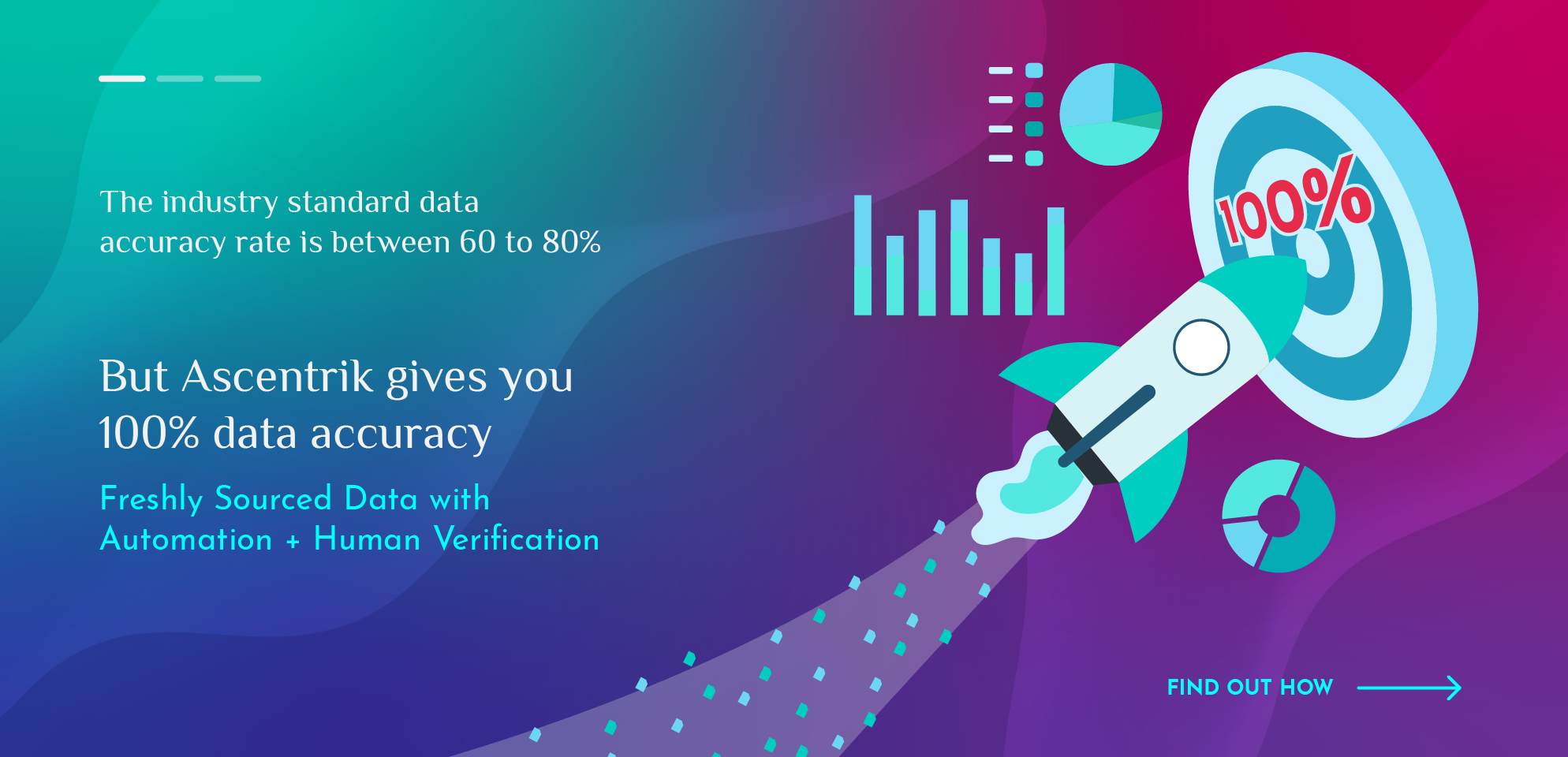
Optimise your lead database with email list cleaning and email validation
Published on 4th October,2021 Last Updated on 18th December,2023
Almost every organisation today owns databases of customer or client information that is used for client relationship management. This information is also used to aid operational, marketing and sales processes. Any activity that involves the use and storage of data, like customer relationship management, marketing automation, customer service, or analytics, all need regular data hygiene processes to be carried out. Although data hygiene is a critical step while carrying out marketing and sales activities, it is often overlooked in most organisations.
Data hygiene through data cleansing, email list validation, and email verification
Data hygiene is the practice of keeping a database clean and accurate by taking steps to ensure its integrity. It involves regular data cleaning, validating, and updating to make sure that it is accurate, up-to-date, complete, consistent, and reliable. This helps organisations avoid costly errors such as incorrect information on customer records or inaccurate segmentation of target audiences.
Why is email list cleaning important?
Have you checked your email open rates and click through rates after running your last email campaign? These are very important to know if your database needs cleansing. If there is a decline in these metrics, you may have a lot of stale contact information in your database. You also need to keep an eye on the number of emails that were unsubscribed to, and how many recipients marked your emails as spam. This is called email list churn or subscribers who bounce, report you as spam, or never even open your emails. When the email list churn is high, it’s very likely that your target audience is not being converted to customers. These are clear signs that it’s the right time for email list cleaning.
When your marketing database becomes unhealthy, you end up wasting time, effort and revenue marketing to the wrong audience.
Data cleansing is the first step in maintaining the hygiene of your database. Data cleaning involves regularly updating your email contact list by cleaning out inactive and outdated contacts. The goal is to avoid email churn, ensure more effective interactions with contacts and thus improve the overall effectiveness of your email campaign.
How to identify records that need email list cleaning?
- Check for those contacts on your list that do not open your emails, and remove them from your list. Check for syntax errors, typos, extra spaces or unsupported characters within words. This is best done by a data provider, or a software.
- Secondly, check for misplaced data which is data that has been entered into the wrong field, or missing data which is data fields that have been left empty. Check also for duplicate data which is identical data that has been entered more than once into your database. And lastly, inconsistent data that conflicts or differs across multiple databases. All these are examples of stale records that need data cleaning.
- Determine low activity subscribers or those that do not open your emails often, and move them to a separate list that receives less marketing communications.
- When email bounces occur, they can be of two types- soft and hard bounces. Soft bounces mean your emails can’t be delivered due to temporary reasons, such as the server being down or too busy, or large email size. Hard bounces occur when your emails get rejected due to permanent reasons, such as invalid addresses, recipients blocking your emails, etc.
During the email list cleaning process, you will have to get rid of the hard-bounced email addresses, and stop mailing soft-bounced addresses until the issue is solved.
Email list validation and email verification
The process of email address validation involves a series of checks which highlight nonexistent or undeliverable addresses in lists. Email list validation involves checking email syntax, email address format, and structure of an email address to ensure it is correctly entered and follows the standard rules. The primary goal is to identify typos, misspellings, or formatting errors that can make an email address “invalid”. It also involves deduplication or removing duplicate email addresses.
You can use email list validation techniques to scan your existing email lists for errors, keep only the ones that are real and engaged, and make sure that any new email addresses that flow into your database are verified.
On the other hand, email address verification goes beyond syntax and format checks. It involves a more in-depth verification process to determine the deliverability of an email address. Email list verification is a set of steps that confirm if an email address exists, if it is non-toxic, and if emails can be delivered. It includes checking the DNS records, and simulating sending an email without actually delivering it. The purpose is to validate the existence of the email address beyond its format and ensure it can receive messages.
Email list verification uses a prominent mail transfer protocol called SMTP (Simple Mail Transfer Protocol) to check if the user’s email address is invalid or non-working. It does this without sending actual emails to that recipient address, but by pinging the SMTP server and analysing its response code.
Although this is a simple approach, there is an overhead involved with SMTP, and email servers often behave unexpectedly. Therefore, you need to choose a reliable email verification provider or software.
Email Validation V/s Email Verification — Are They Same?
Even though both functions are very similar and ensure the accuracy and quality of your email lists, email list validation and email verification are two different processes.
Together these processes constitute data hygiene and help organisations comply with data privacy regulations and laws, especially those related to consumer data protection. It helps organisations protect themselves from malicious activities like identity theft or fraud.
The Benefit of Data Hygiene when it comes to Email Marketing
When databases contain inaccurate or incomplete data, marketing campaigns can turn out to be costly. Messages that are sent to an outdated list of contacts will not only fail to generate new leads, but they can damage brand reputation. On the flip side, having clean data helps ensure targeted emails reach the right people, who are more likely to become customers.
15.8% of all emails go missing or have been caught by popular spam filters, i.e., one in ten emails either get lost in the spam folder or blocked by the email service provider. This can hurt your email campaign performance, reputation, and revenue. (Emailtooltester.com)
If your email list contains invalid, outdated, or fake email addresses, you are likely to face high bounce rates, spam complaints, and low engagement. That’s why email validation is essential for maintaining good data quality of your lists and good campaign performance.
When email validation, email verification and data cleansing are implemented properly, it leads to high quality databases and campaign performance. Here’s how…
How Email Address Validation & Email Verification Benefits Your Email Campaigns?
● Removes emails that degrade your email list quality
The main function of email address verification is stopping invalid & bad email addresses (disposables, spam traps, blacklisted, catch-alls, etc) from entering and degrading the quality of your email lists.
With proper email validation, you ensure that your sales teams and email campaigns are running on accurate data leading to further benefits.
● Minimising bounce rates
Email address verification lets you know which email addresses are incorrect, undeliverable, role-based, accept-all, and so on. With this knowledge in hand, you can know which addresses to discard and prevent email bounces.
● Solves low deliverability issues
If you have low deliverability and you don’t take measures to fix it, ISPs think of you as a spammer. This leads to more and more of your emails landing in the spam folder, even for your engaged recipients.
The best way to solve the deliverability issue is with proper email address validation and verification methods. When you reduce bounces and gain your ISP’s trust, you achieve better deliverability.
● Reduces the chances of being blacklisted
The likelihood that your account would be blacklisted increases the more hard bounces you receive or in case you land into a spam trap. This will also occur if you have very low engagement, and your email list contains invalid email addresses. Your subsequent emails are very likely to be delivered to spam.
You lower these risks by authenticating the email addresses on your list.
● Saves resources being spent on chasing invalid leads
Many email address verification providers charge based on the number of contact records on your list. You may end up paying a larger subscription fee if your list is bloated with hundreds of invalid email addresses.
Maintaining a valid and clean email list and avoiding subscription fees are both made possible by running an email validation.
● Increases email campaign ROI
Email address validation allows you to create and send out targeted email campaigns. By sending fewer and more precise emails, your campaign expenditure decreases, while your chances of deliverability and engaging the receiver increases.
So, with email address verification, your resources are being used more effectively, your expenses decrease, and your revenues most likely increase. This increases your ROI, for every dollar you invest.
Double opt-ins and how they help in email list validation and verification
After email verification, we can go a step further and ensure consent as well. This is known as double opt-in, which is a part of consent based marketing. It is another effective method for determining whether an email is valid and whether the domain exists. In this method, a confirmation email is sent to the provided email address, and the user then confirms their email address to sign up.
At Ascentrik Research we use our proprietary email validation tool, as well as the single and double opt in method to capture user consent. This allows you to capture high-quality leads, resulting in increased deliverability, open rates and conversion rates.
Freshly sourced data with an accuracy rate of 100%
Freshly sourced data with an accuracy rate of 100%With most top data vendors, it's an accepted fact that data accuracy rates are between 60 to 80%. This eventually leads to at least a 5% bounce rate on your email marketing campaigns. This is because data stored in...
Preparing for a possible economic slowdown with data analytics
[dsm_perspective_image src="https://www.ascentrik.com/wp-content/uploads/2022/08/Economic-recession.jpg" alt="The Impact of Data Cleansing and Validation on your Marketing Efforts" title_text="Economic recession" align="center" force_fullwidth="on"...
Noteworthy Developments in the Pharma and Biotech Industry
[dsm_perspective_image src="https://www.ascentrik.com/wp-content/uploads/2022/06/may-blog.png" alt="The Impact of Data Cleansing and Validation on your Marketing Efforts" title_text="Developments in the Pharma and Biotech Industry" align="center" force_fullwidth="on"...


